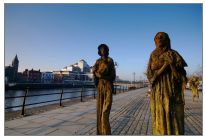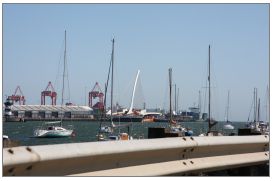In Dublin's Fair City: the URBACT Sumer University
Edited on
09 February 2015Dublin is a frequent partner city in URBACT projects. As it prepares to welcome delegates to the URBACT Summer University in August, we look at the Irish capital’s approach to urban development, and the benefits of its participation in four URBACT projects.
The Growth of Cruise Ship Tourism
James Joyce wouldn't believe his eyes: in the port of Dublin so often mentioned in his books, enormous cruise ships the length of three football pitches are arriving every week, disembarking more than 100,000 tourists a year onto the city streets. These foreign visitors soak up the city’s famous literary atmosphere – and spend millions of euros in its shops. 
Part of the success of this development is thanks to Dublin's participation in the URBACT CTUR Port Cities project, which completed in 2011. "The project brought the City Council and the port authority together," explains John O'Hara, Deputy City Planning Officer responsible for the Development Plan. "Before that we worked in parallel eco-systems." In fact the two authorities had first worked together to build a tunnel from the port to the city ring road to divert container lorries from the city's congested River Liffey quays. That tunnel was opened in 2006.
A Benefit to Both Sides
Then came the URBACT Ports project, which brought the two even closer together. They negotiated on plans to improve berthing for even bigger cruise ships arriving in Dublin, and to make the 3km link from the port to the city centre more attractive to tourists. "Both sides saw the benefit of it," John O'Hara says. "Gradually the port and the city see there's a symbiotic relationship. A lot of that happened through the URBACT cruise-ships initiative."
Dublin has been through some major upheavals in recent years. After the boom years of the "Celtic Tiger" from the mid-1990s, there was the sudden economic crash in 2008. Ireland went from an unemployment rate of 5% to an average of 14% - even 17% among people in their 20s. For the first time in years (like Joyce himself!) young people began to leave the country.
The Raw Nerve of Emigration

"Emigration is a raw nerve in this country because it's been the hemorrhaging of the country's brightest and best for a long time. We didn't think in the last three or four years we would see its re-emergence," John says. But he is modestly optimistic that the 1.2 million population of the greater Dublin region is showing some growth.
In recent years there has been an influx of immigrants to the city and they now make up between 15 and 20% of the population, particularly Poles and Chinese. This phenomenon was the subject of Dublin's participation in another now completed URBACT project, OPENCities. "They bring benefits in ways we hadn’t foreseen," John explains. "They make better use of our urban open space, for example. You often see families at the weekend along the quays and the Phoenix Park, more so than the indigenous Irish."
Currently the city is a partner in two more URBACT projects. In URBACT Markets project, its strategy is to change the profile of the historic city-centre Fruit & Vegetable Market from a wholesale to a retail outlet, encouraging the city's food economy and working on the conservation of the market hall's protected Victorian structure. "This is an opportunity to attract people into the area and then kick-start it again, like the Borough Market in London," John explains.
Promoting a More Compact, Sustainable City
The second project is USE ACT, on urban renewal. The subject is in line with the City Council's development strategy to promote a more compact, sustainable city. It is managing the city's population growth by trying to brin
g people back from some of the far-flung commuter towns they moved to when property prices were booming, sometimes travelling 100km by car each way to reach their places of work.
The City Council has Local Action Plans to create two big new neighbourhoods on the Dublin outskirts: one close to the airport on the north side and Pelletstown to the west, both situated on main railway lines. "O
ing for single people, elderly people as well, so people will want to live in those areas, rather than live 30-40 miles out with the added cost of private car transport etc in the future," John explains. "We only have 500 hectares of space left undeveloped in the city, so that's why we need to make good use of it."ur policy is to have mixed typology in those areas: family housing, hous
The Docklands Success Story

In addition, as part of the USE ACT project, Dublin has developed a strategy for developing the city's brownfield sites. "This URBACT project and others we've been involved in are about how to make good use of the urban land," John says. "We have 200 vacant sites in the inner city, anything from a couple of houses missing up to large sites of 10-12 hectares. So we're actively looking at how to kick-start those areas. We're trying to do a database of all those areas – find out who the owner is, trying to bring in disincentives, such as local taxes, to make sure that they bring those sites into play as part of the city. Not only are they an eyesore but they’re a loss to the city."
The success story in Dublin's development in the past 20 years has been the transformation of its Docklands into financial services centres and businesses. Begun in 1987, it is continuing with a second phase, to develop 22 hectares of land in the North Lotts and Grand Canal Dock area. The City Council's plan is helped by the existing infrastructure in the area. The Luas tram system, with a network of 54 stations and 36km of track, has a line running along the north side of the Docklands district. "We have hubs of creativity down there already that will act as magnets: Google, that employs 2,000-3,000 people, and Facebook," John says. "On the culture front we have the new Dublin conference centre that brings delegates to the area and a 2,000-seater theatre at Grand Canal Dock. So it's not just an office park, it's about attracting vitality and variety into that area. For us, URBACT has been a way to crystallise these issues and bring them to the citizens and the elected representatives of the city."
Read more:
- URBACT Summer University - website
- URBACT MARKETS Project - website
- USE ACT Project - website
- OPENCITIEs Project - website
- CTUR Project - website
Submitted by admin on
